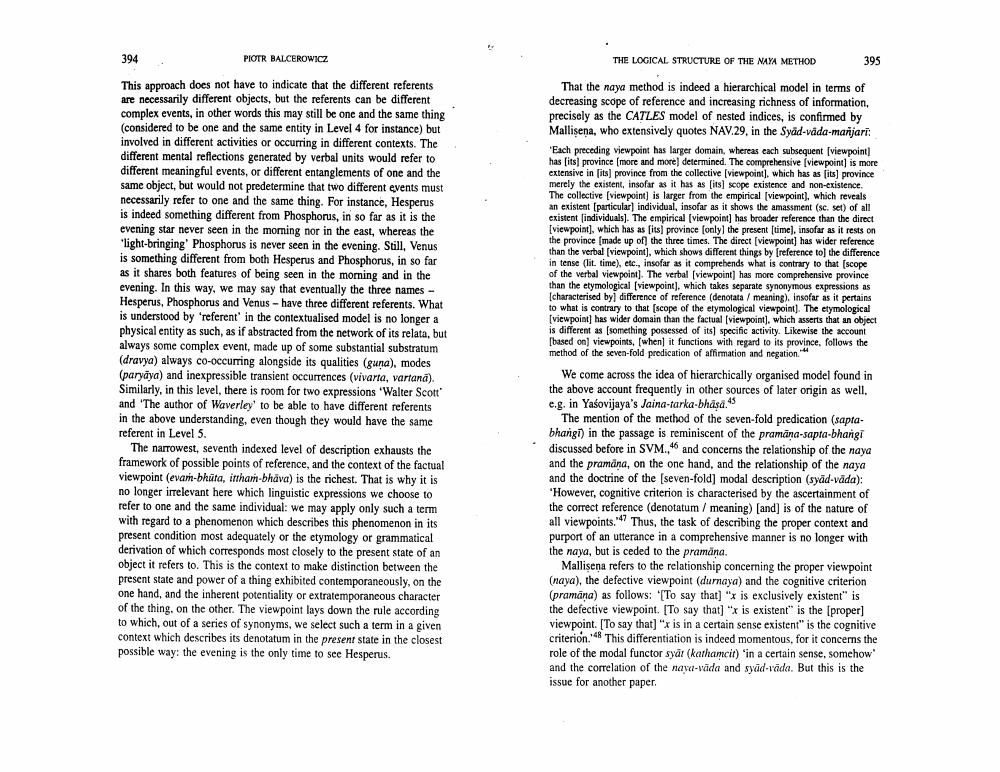Book Title: Logical Structure Of Naya Method Of Jainas Author(s): Piotr Balcerowicz Publisher: Piotr Balcerowicz View full book textPage 9
________________ 394 PIOTR BALCEROWICZ THE LOGICAL STRUCTURE OF THE NAYA METHOD 395 This approach does not have to indicate that the different referents are necessarily different objects, but the referents can be different complex events, in other words this may still be one and the same thing (considered to be one and the same entity in Level 4 for instance) but involved in different activities or occurring in different contexts. The different mental reflections generated by verbal units would refer to different meaningful events, or different entanglements of one and the same object, but would not predetermine that two different events must necessarily refer to one and the same thing. For instance, Hesperus is indeed something different from Phosphorus, in so far as it is the evening star never seen in the moming nor in the east, whereas the "light-bringing' Phosphorus is never seen in the evening. Still, Venus is something different from both Hesperus and Phosphorus, in so far as it shares both features of being seen in the morning and in the evening. In this way, we may say that eventually the three names - Hesperus, Phosphorus and Venus - have three different referents. What is understood by referent in the contextualised model is no longer a physical entity as such, as it abstracted from the network of its relata, but always some complex event, made up of some substantial substratum (dravya) always co-occurring alongside its qualities (guna), modes (paryaya) and inexpressible transient occurrences (vivarta, vartand). Similarly, in this level, there is room for two expressions 'Walter Scott and 'The author of Waverley' to be able to have different referents in the above understanding, even though they would have the same referent in Level 5. The narrowest, seventh indexed level of description exhausts the framework of possible points of reference, and the context of the factual viewpoint (evar-bhūta, itham-bhava) is the richest. That is why it is no longer irrelevant here which linguistic expressions we choose to refer to one and the same individual: we may apply only such a term with regard to a phenomenon which describes this phenomenon in its present condition most adequately or the etymology or grammatical derivation of which corresponds most closely to the present state of an object it refers to. This is the context to make distinction between the present state and power of a thing exhibited contemporaneously, on the one hand, and the inherent potentiality or extratemporaneous character of the thing, on the other. The viewpoint lays down the rule according to which, out of a series of synonyms, we select such a term in a given context which describes its denotatum in the present state in the closest possible way, the evening is the only time to see Hesperus. That the naya method is indeed a hierarchical model in terms of decreasing scope of reference and increasing richness of information, precisely as the CATLES model of nested indices, is confirmed by Mallisena, who extensively quotes NAV.29, in the Syád-våda-manjari: Each preceding viewpoint has larger domain, whereas each subsequent [viewpoint) has its) province (more and more determined. The comprehensive (viewpoint is more extensive in its) province from the collective (viewpoint), which has as its) province merely the existent, insofar as it has as [its) scope existence and non-existence. The collective [viewpoint) is larger from the empirical viewpoint), which reveals an existent (particular individual, insofar as it shows the amassment (sc. set) of all existent individuals). The empirical (viewpoint) has broader reference than the direct [viewpoint), which has as its province only the present time), insofar as it rests on the province (made up of the three times. The direct (viewpoint) has wider reference than the verbal viewpoint), which shows different things by (reference to the difference in tense (lat.time), etc., insofar as it comprehends what is contrary to that (scope of the verbal viewpoint). The verbal (viewpoint) has more comprehensive province than the etymological (viewpoint), which takes separate synonymous expressions as (characterised by difference of reference (denotata / meaning), insofar as it pertains to what is contrary to that scope of the etymological viewpoint). The etymological [viewpoint) has wider domain than the factual [viewpoint), which asserts that an object is different as something possessed of its) specific activity. Likewise the account [based on) viewpoints, when it functions with regard to its province, follows the method of the seven-fold predication of affirmation and negation We come across the idea of hierarchically organised model found in the above account frequently in other sources of later origin as well. e.g. in Yaśovijaya's Jaina-tarka-bhasa." The mention of the method of the seven-fold predication (saptabhangi) in the passage is reminiscent of the pramâna-sapta-bhangi discussed before in SVM., 46 and concerns the relationship of the naya and the pramana, on the one hand, and the relationship of the naya and the doctrine of the seven-fold) modal description (syad-vāda): "However, cognitive criterion is characterised by the ascertainment of the correct reference (denotatumn / meaning) (and) is of the nature of all viewpoints. 47 Thus, the task of describing the proper context and purport of an utterance in a comprehensive manner is no longer with the naya, but is ceded to the pramana. Mallisena refers to the relationship concerning the proper viewpoint (naya), the defective viewpoint (duraya) and the cognitive criterion (pramana) as follows: 'To say that] "x is exclusively existent" is the defective viewpoint. To say that] "x is existent" is the proper] viewpoint. (To say that] "x is in a certain sense existent" is the cognitive criterion. This differentiation is indeed momentous, for it concerns the role of the modal functor syar (kathamcit) 'in a certain sense, somehow and the correlation of the navi-vāda and syūd-rāda. But this is the issue for another paper,Page Navigation
1 ... 7 8 9 10 11 12 13
